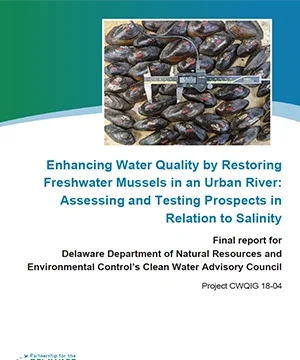Abstract or Summary

Native species of freshwater mussels were found to tolerate and grow in size at all tidal study sites on the lower Christina River in New Castle County, Delaware. At least some mussels from a common, hatchery-propagated cohort were able to survive and grow at all sites, and the growth rates of the survivors exceeded the growth of mussels a non-tidal stream site (Winterthur) that served as a reference location. This positive result was in spite of variable water quality, relatively high suspended solid concentrations, and a few significant storm events that contributed to spikes in specific conductivity. Nevertheless, the survival of deployed mussels at the tidal Christina study sites was lower than at the reference site due to several factors. Experimental errors in the form of cage losses due to severe storm events or vandalism were not considered in the survival analysis. After accounting for such losses, the lower survival at study sites compared to the reference appeared to mainly be associated with predation based on discrete shell breakage patterns witnessed on the recovered shells. The type of predator is unclear, but blue crabs, crayfish, raccoons and other animals exist within the study area. Although not part of the original study design, a subset of mussels was also deployed into experimental “mussel enhancement habitats” at one of the study sites to preliminarily test whether stabilization of soft bottom habitats might increase habitat suitability for mussels. The experimental plots consisted of unbounded “V” and “W” shaped strings of small gabions filled with oyster shell, around which mussels were deployed, as compared to mussels deployed in an unprotected control plot.
The preliminary design and budget precluded replication for statistical analyses, however, after nearly five months more than twice as many tagged mussels were re-surveyed in these gabion-stabilized plots compared to the untreated plot, and growth was comparable during the deployment period. All surviving mussels from the initial cage and gabion study were relocated to small tributary streams that were deemed to be conducive for mussels based on the existence of small numbers of extant, wild mussels. A subsequent survey of the tributaries for these free released, tagged mussels found that most had perished or disappeared, presumably due to predation. Outcomes from this project confirm that the water quality and food conditions of the lower Christina, while not always ideal, are sufficient to support good growth and survival of native species of freshwater mussels.
The early indications from the gabion study also suggest that habitat modification tactics may plausibly help to stabilize and enhance mussel habitat suitability, which should be useful for designing living shorelines that could contain mussel beds as one feature in the subtidal terraces of the project area. Results of this study also indicate, however, that predation pressure will be an important constraint on mussel restoration or mussel-based living shorelines in the tidal Christina River. Future studies should examine which species and sizes of mussels are most vulnerable to this predation, and then develop predator management practices to either protect sensitive sizes or species or to only release mussels that are of a species or size that has lower predation risk. Both mussel bed restoration projects and mussel-based living shoreline projects are plausible tactics that merit greater investigation for tidal freshwater areas of Delaware, such as the lower Christina River.
There is increasing interest in restoring and enhancing native mussel populations because of their increasingly recognized contribution to water clarity, particle removal, and nutrient pollutant recycling/sequestration. Results of this study suggest that food quality and quantity should not be a constraint on mussel carrying capacity in the particle-rich lower Christina River. Hence, projects aimed at enhancing mussel beds for ecosystem services are warranted, and we recommend that additional studies begin to develop and test different tactics for enhancing mussel habitat suitability and protecting mussels from predators, with a goal of boosting mussel densities and habitat carrying capacity per acre.